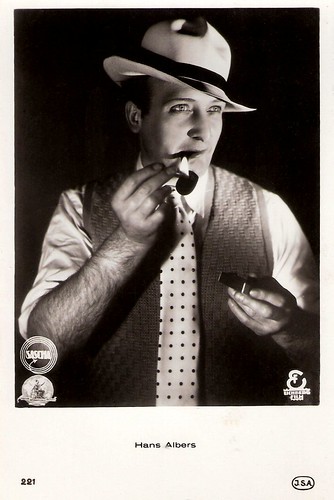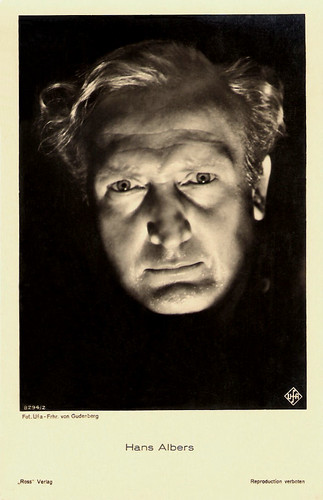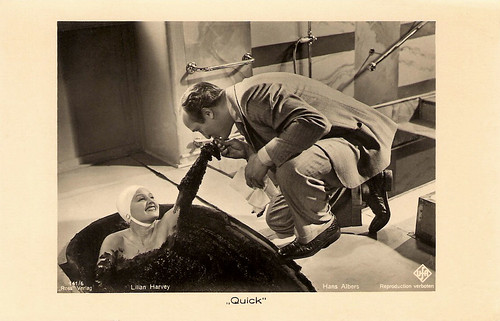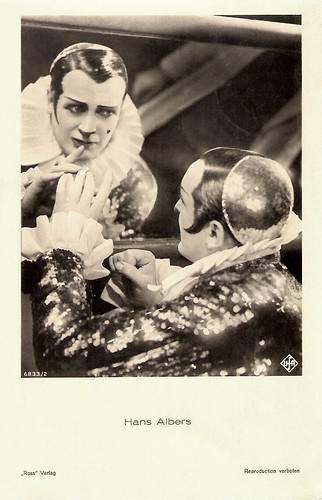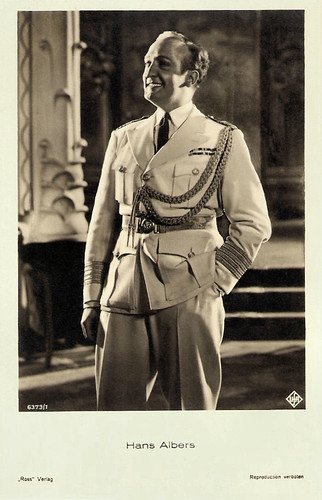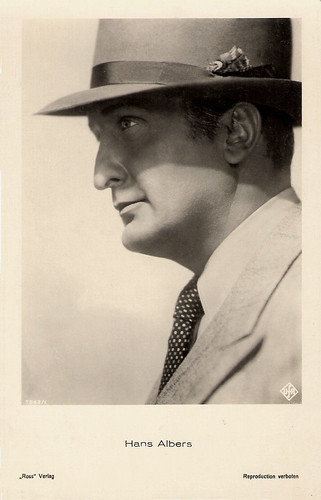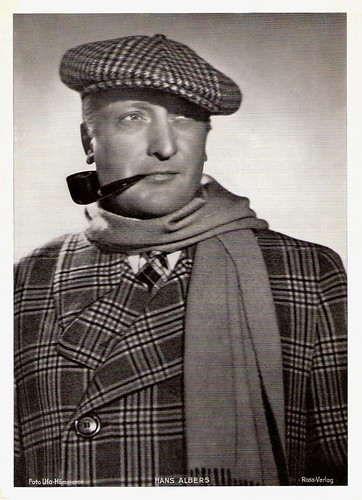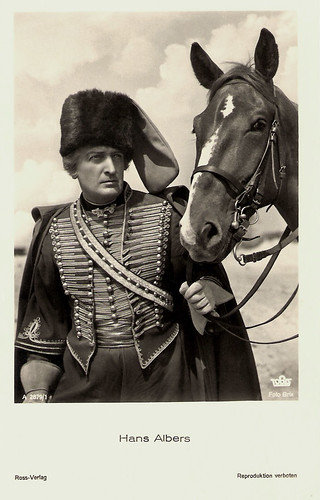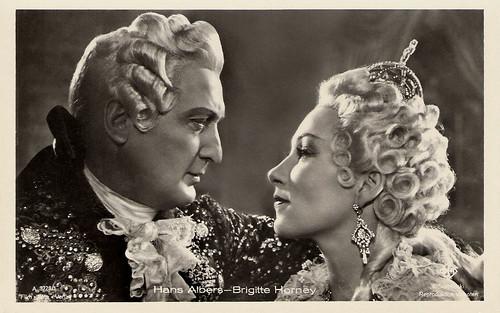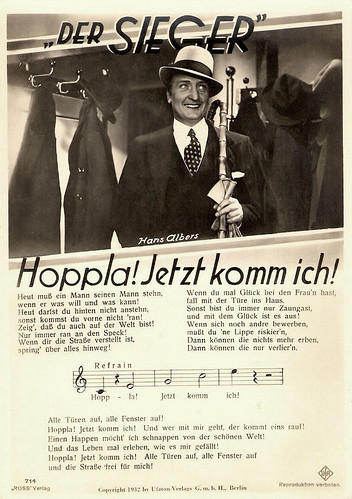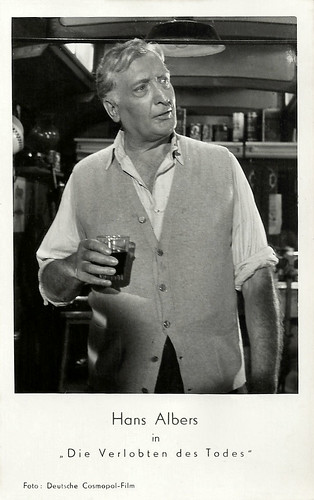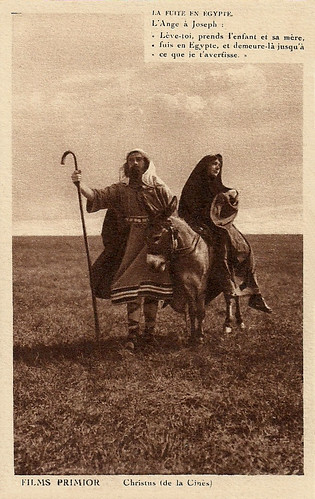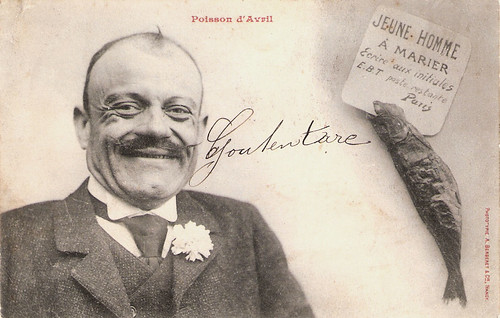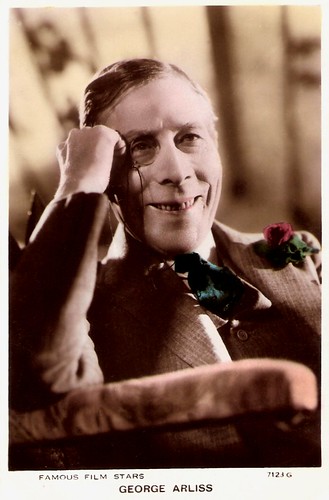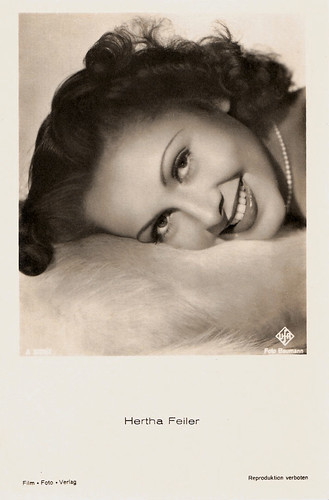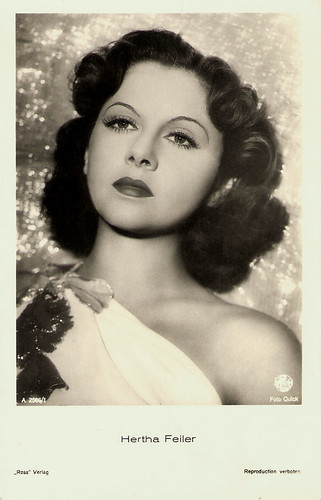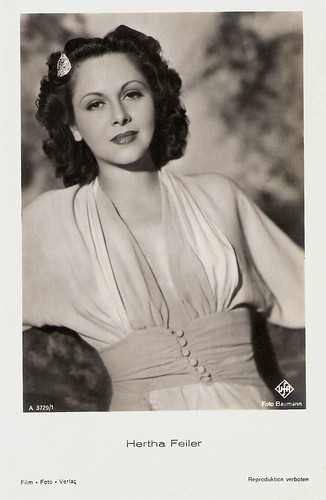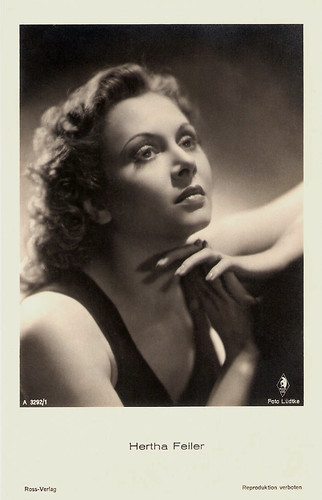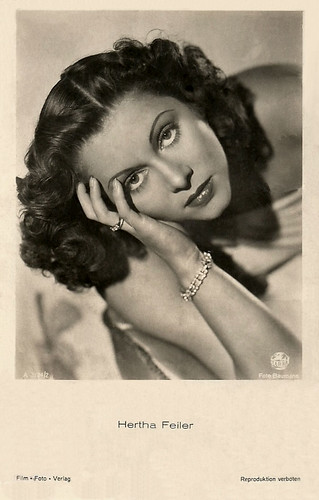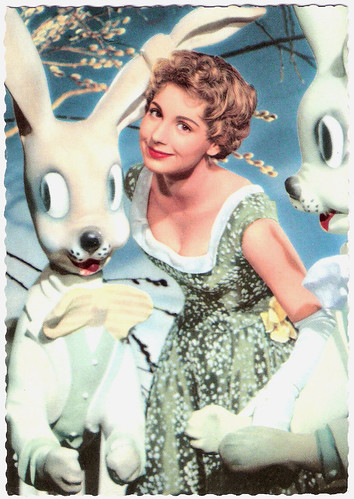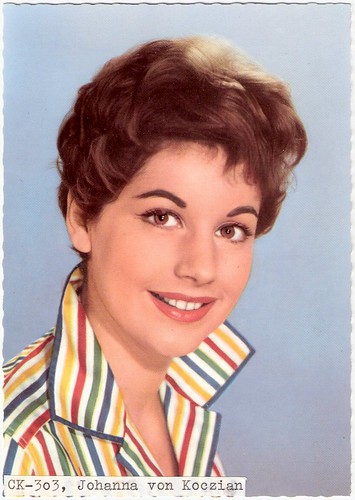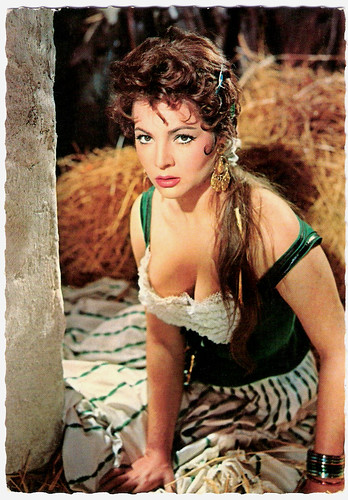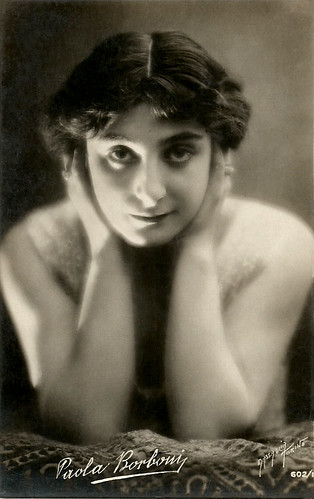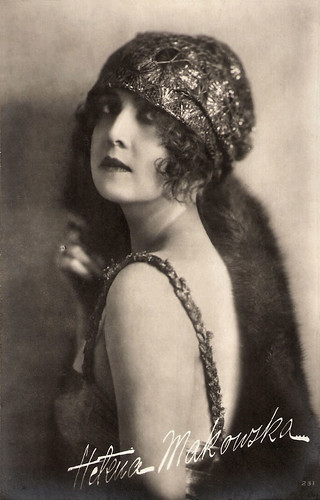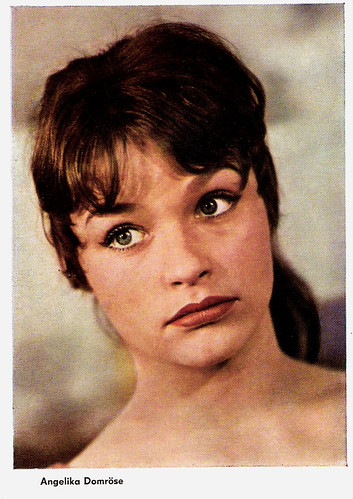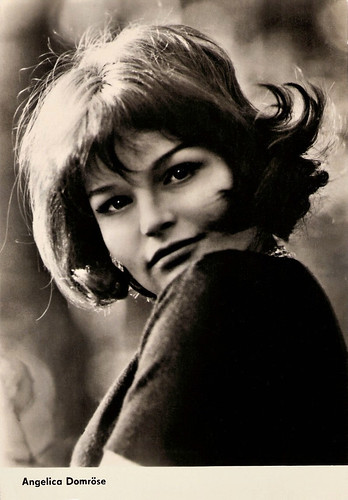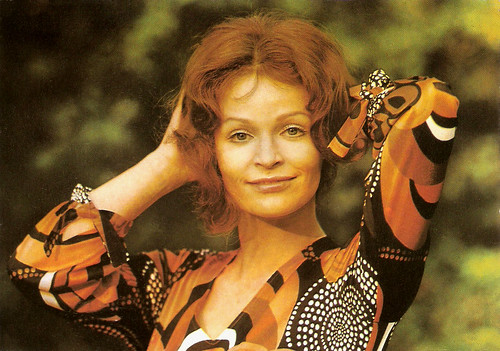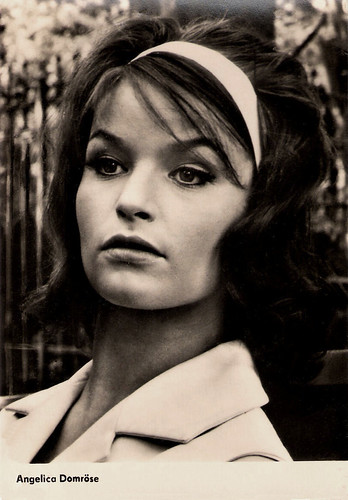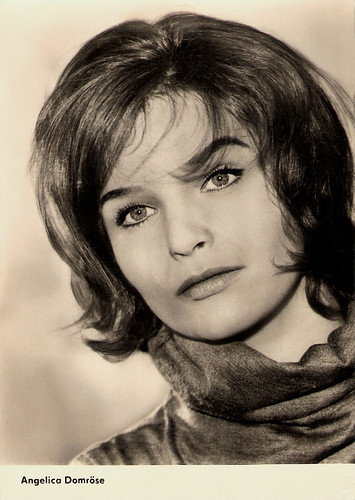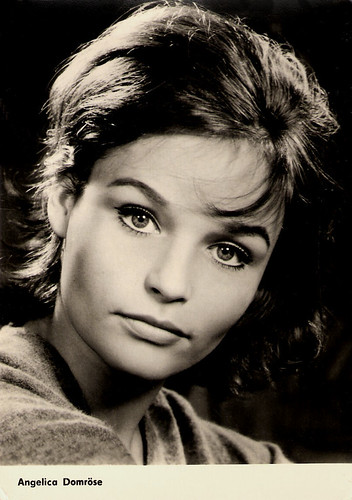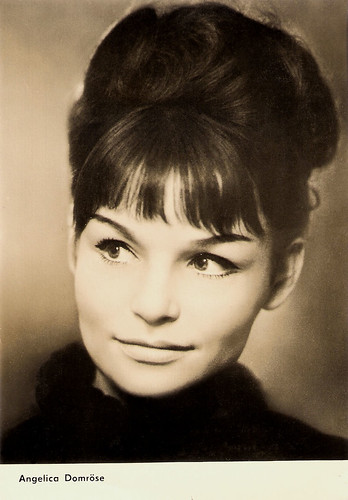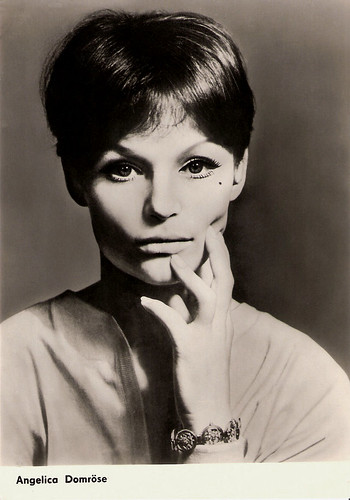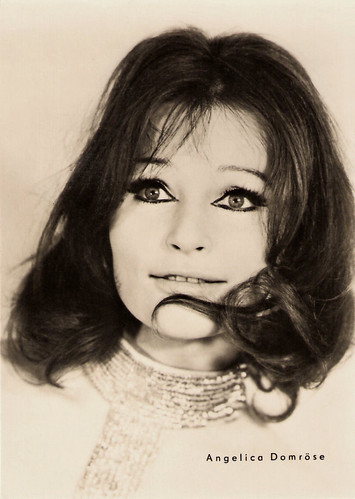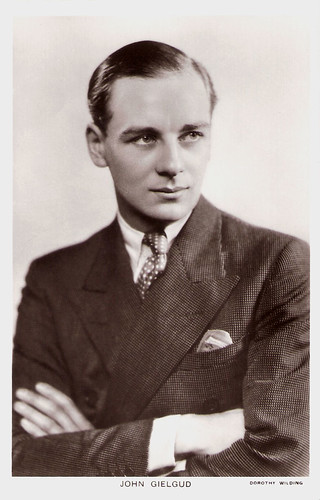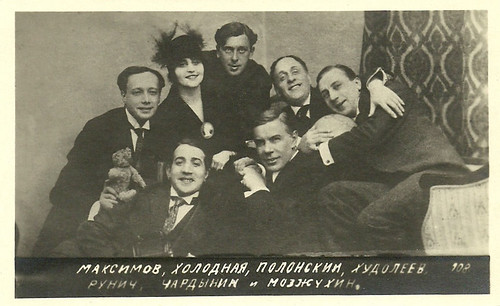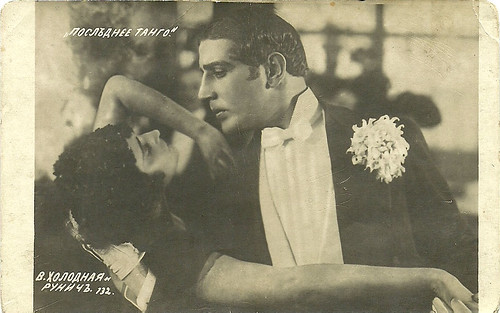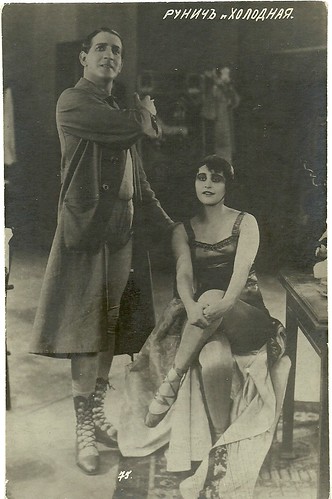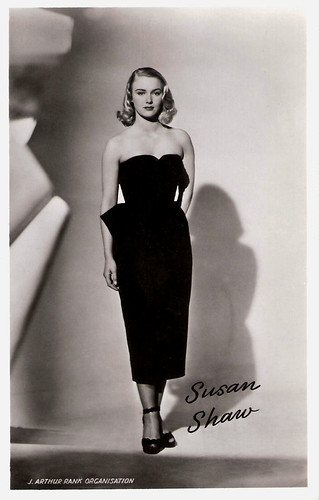Blond and blue-eyed Mario Girotti (1939) is better known as Terence Hill. The Italian actor starred in multiple action films and spaghetti westerns. In 19 of these films he appeared together with his partner Bud Spencer. Their success made him one of the highest paid European film stars.
![Mario Girotti (Terence Hill)]()
Italian postcard by Bromofoto, Milano (Milan), no. 1807.
![Mario Girotti, Federica Ranchi]()
East-German postcard by VEB Progress Film-Vertrieb, Berlin, no. 1.087, 1959. Retail price: 0,20 DM. Photo: publicity still for La grande strada azzurra/The Wide Blue Road (1957, Gillo Pontecorvo, Maleno Malenotti).
![Mario Girotti]()
German postcard by Graphimo, Berlin.
![Mario Girotti]()
Romanian collector's Card by Coop Arta Manual, Sibiu.
Euro-westerns
Mario Girotti was born in Venice, Italy, in 1939. His mother Hildegard Thieme was German, his father Girolamo Girotti an Italian chemist. As a child he lived in the small town of Lommatzsch, near Dresden, Germany, from 1943 to 1945. During World War II, he survived the Dresden Bombing by the alies. Back in Italy and living in Rome, one of his hobbies was swimming. He swam for the Roman team Lazio and even won a bronze medal. During practice, he would often meet Bud Spencer, then still known as Carlo Pedersoli, who swam for the same team. Terence also enjoyed rowing and won a silver medal with his rowing team. He was discovered by Italian filmmaker Dino Risi at a swimming meet and he made his first film at the age of 12, Vacanze col Gangster/Vacation With a Gangster (1951, Dino Risi). He continued acting to finance his motorcycle and his studies classical literature at the University of Rome. He appeared in 27 Italian films, including Gli sbandati/Abandoned (1955, Francesco Maselli). Then he landed a supporting role in Luchino Visconti's masterpiece Il Gattopardo/The Leopard (1963). The film was based on the classic novel by Giuseppe Tomasi Di Lampedusa and had a star cast with Burt Lancaster, Claudia Cardinale and Alain Delon. The film was a big success and Girotti decided to leave university to become a full-time actor. He signed a contract with German producer Horst Wendtland for a series of adventure and western films in Germany. Hill speaks German fluently. He appeared in the popular euro-westerns Winnetou - 2. Teil/Winnetou: Last of the Renegades (1964, Harald Reinl), Unter Geiern/Among Vultures (1964, Alfred Vohrer), Der Ölprinz/Rampage at Apache Wells (1965, Harald Philipp) and Old Surehand/Flaming Frontier (1965, Alfred Vohrer), all based on the Winnetou and Old Shatterhand-novels by German author Karl May. He also appeared in the fantasy epic Die Nibelungen/Those Whom the Gods Wish to Destroy (1966, Harald Reinl), a remake of the classic silent film by Fritz Lang.
![Karin Dor and Mario Girotti (Terence Hill) in Winnetou II]()
German postcard, no. R 16. Photo: publicity still from Winnetou - 2. Teil/Last of the Renegades (1964) with Karin Dor.
![Mario Girotti (Terence Hill) and Mila Baloh in Unter Geiern]()
German postcard, no. 45. Photo: Rialto. Publicity still for Unter Geiern/Among Vultures (1964) with Mila Baloh.
![Mario Girotti (Terence Hill), Der Ölprinz]()
German postcard, no. 8. Photo: Rialto / Constantin. Publicity still for Der Ölprinz/Rampage at Apache Wells (1965, Harald Philipp). Caption: "Der Treck hat verabredungsgemäss die erste Etappe am Fluss erreicht. Heimlich schleicht sich der junge Forsyth aus dem Lager und trifft sich mit Mitgliedern der Finders-bande im Blockhaus. Hier empfängt er seine Instruktionen; denn die Findersbande soll im Austrag des Ölprinzen nachts die Wagenburg überfallen." (The trek reaches according to appointment to the first stage near the river. The young Forsyth secretly sneaks out of the camp and meets with members of the Finders gang in the blockhouse. Here he receives his instructions, for the Finders gang will in the discharge of the Oil prince attack the wagons during the night.)
Trinity
In 1967, Mario Girotti returned to Italy to act in Dio perdona... Io no!/God Forgives, I don't (1968, Giuseppe Colizzi). While on location in Almeria, Spain, he married an American girl of Bavarian descent, Lori Zwicklbauer, who was the dialogue coach for the picture. Girotti changed his name to Terence Hill. The name was made up, as a publicity stunt, by the film producers. Girotti had 24 hours to choose from a list of twenty names and picked the one with his mother's initials (Hildegard Thieme). The producers told the public that ‘Hill’ was his wife's name for publicity reasons. (At this time of upcoming feminism, a man who took his wife's name was something special.) His co-star was Carlo Pedersoli who was renamed as Bud Spencer. Both had participated in the film Annibale/Hannibal (1959, Carlo Ludovico Bragaglia, Edgar G. Ulmer) but they had never met on the set since they always appeared in different scenes. In the following years, they starred in another 17 comic action films and spaghetti westerns. Dio perdona... Io no! became the film with the highest number of spectators in Italian cinemas, and stayed so until 1986. Director Giuseppe Colizzi called both actors back for the sequels I quattro dell’Ave Maria/Ace High (1968, Giuseppe Colizzi) and La collina degli stivali/Boot Hill (1969, Giuseppe Colizzi). Their films were incredibly successful in Italy but also abroad. Many of these films have alternate titles, depending upon the country and distributor. Possibly their most famous film is the western Lo chiamavano Trinità/They Call Me Trinity (1971, Enzo Barboni aka E.B. Clucher). Here Terence showed his talent as a comedian for the first time. Director Barboni had invented the characters Trinity and Bambino, the two protagonists of the films. The smart charmer Hill and dumb heavyweight Spencer were a hilariously funny team, which returned in the sequel Continuavano a chiamarlo Trinità/Trinity Is STILL My Name! (1972, Enzo Barboni). These and all the following films contain the typical bar fights with people flying everywhere and lots of hilarious cheap jokes. According to his official website, Hill’s favorite film is Il mio nome è Nessuno/My Name Is Nobody (1973, Tonino Valerii and, uncredited, Sergio Leone), in which he co-starred with Henry Fonda. Terence plays a young, mysterious loner named Nobody who tries his hardest to make his aging outlaw hero go out in a blaze of glory.
![Mario Girotti (Terence Hill), Miou Miou, Raimund Harmstorf]()
Terence Hill with Miou Miou and Raimund Harmstorf. German promocard. Photo: publicity still for Un genio, due compari, un pollo/The Genius (1975, Damiano Damiani).
![Mario Girotti (Terence Hill)]()
Italian postcard by Alterocca, Ferni.
![Bud Spencer]()
Bud Spencer. Italian postcard by Alterocca, Ferni.
Don Camillo
In 1976 Hollywood called and Terence Hill appeared in March or Die (1977, Dirk Richards) with Gene Hackman and Catherine Deneuve, and he starred in Mr. Billion (1977, Jonathan Kaplan) with Valerie Perrine. Since then he divided his time between Italy and the US. He directed and produced himself in the remake Don Camillo (1983), and in Lucky Luke (1991), a mediocre adaptation of the famous cartoon by Morris & Goscinny. His last film was the actioner Cyberflic (1997, Antonio Margheriti). Hill then moved on to a successful television career in Italy. In 2000, he landed the leading role in the Italian television series Don Matteo (2000-2011), as a crime-fighting parish priest. For his performance of 'Don Matteo', Terence received the 'Outstanding Actor of the Year' award at the 42nd International Television Festival of Monte Carlo. The series endured for 172 episodes. Recently he returned to the western with the TV-film Doc West (2009, Giulio Base, Terence Hill) with Paul Sorvino and Ornella Muti. Most recently, he played the lead in the TV series Un passo dal cielo/A step from heaven (2011-2012). A new season is scheduled for 2014. Terence Hill lives in Massachusetts. He and his wife Lori had two sons, Jesse (1969) and their adopted son Ross (1973). Ross was killed in a car accident in New Mexico in 1990 while Terence Hill was preparing to film Lucky Luke on the Bonanza Creek Ranch near Santa Fe.
Scene with a young Mario Girotti and Carlo Pedersoli in Vacanze col Gangster/Vacation With a Gangster (1951). Source: Giorgio 1942 (YouTube).
Bud Spencer & Terence Hill - Best of. Source: Spiros 65 (YouTube).
Terence Hill as Don Camillo. Source: godofthunder1976 (YouTube).
Sources: Klaus Bobacz (IMDb), Sandra Brennan (AllMovie), TerenceHill.com, SpencerHill.de (German), Wikipedia and IMDb.

Italian postcard by Bromofoto, Milano (Milan), no. 1807.

East-German postcard by VEB Progress Film-Vertrieb, Berlin, no. 1.087, 1959. Retail price: 0,20 DM. Photo: publicity still for La grande strada azzurra/The Wide Blue Road (1957, Gillo Pontecorvo, Maleno Malenotti).

German postcard by Graphimo, Berlin.

Romanian collector's Card by Coop Arta Manual, Sibiu.
Euro-westerns
Mario Girotti was born in Venice, Italy, in 1939. His mother Hildegard Thieme was German, his father Girolamo Girotti an Italian chemist. As a child he lived in the small town of Lommatzsch, near Dresden, Germany, from 1943 to 1945. During World War II, he survived the Dresden Bombing by the alies. Back in Italy and living in Rome, one of his hobbies was swimming. He swam for the Roman team Lazio and even won a bronze medal. During practice, he would often meet Bud Spencer, then still known as Carlo Pedersoli, who swam for the same team. Terence also enjoyed rowing and won a silver medal with his rowing team. He was discovered by Italian filmmaker Dino Risi at a swimming meet and he made his first film at the age of 12, Vacanze col Gangster/Vacation With a Gangster (1951, Dino Risi). He continued acting to finance his motorcycle and his studies classical literature at the University of Rome. He appeared in 27 Italian films, including Gli sbandati/Abandoned (1955, Francesco Maselli). Then he landed a supporting role in Luchino Visconti's masterpiece Il Gattopardo/The Leopard (1963). The film was based on the classic novel by Giuseppe Tomasi Di Lampedusa and had a star cast with Burt Lancaster, Claudia Cardinale and Alain Delon. The film was a big success and Girotti decided to leave university to become a full-time actor. He signed a contract with German producer Horst Wendtland for a series of adventure and western films in Germany. Hill speaks German fluently. He appeared in the popular euro-westerns Winnetou - 2. Teil/Winnetou: Last of the Renegades (1964, Harald Reinl), Unter Geiern/Among Vultures (1964, Alfred Vohrer), Der Ölprinz/Rampage at Apache Wells (1965, Harald Philipp) and Old Surehand/Flaming Frontier (1965, Alfred Vohrer), all based on the Winnetou and Old Shatterhand-novels by German author Karl May. He also appeared in the fantasy epic Die Nibelungen/Those Whom the Gods Wish to Destroy (1966, Harald Reinl), a remake of the classic silent film by Fritz Lang.
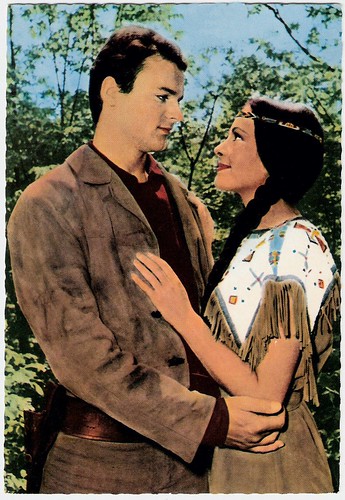
German postcard, no. R 16. Photo: publicity still from Winnetou - 2. Teil/Last of the Renegades (1964) with Karin Dor.

German postcard, no. 45. Photo: Rialto. Publicity still for Unter Geiern/Among Vultures (1964) with Mila Baloh.

German postcard, no. 8. Photo: Rialto / Constantin. Publicity still for Der Ölprinz/Rampage at Apache Wells (1965, Harald Philipp). Caption: "Der Treck hat verabredungsgemäss die erste Etappe am Fluss erreicht. Heimlich schleicht sich der junge Forsyth aus dem Lager und trifft sich mit Mitgliedern der Finders-bande im Blockhaus. Hier empfängt er seine Instruktionen; denn die Findersbande soll im Austrag des Ölprinzen nachts die Wagenburg überfallen." (The trek reaches according to appointment to the first stage near the river. The young Forsyth secretly sneaks out of the camp and meets with members of the Finders gang in the blockhouse. Here he receives his instructions, for the Finders gang will in the discharge of the Oil prince attack the wagons during the night.)
Trinity
In 1967, Mario Girotti returned to Italy to act in Dio perdona... Io no!/God Forgives, I don't (1968, Giuseppe Colizzi). While on location in Almeria, Spain, he married an American girl of Bavarian descent, Lori Zwicklbauer, who was the dialogue coach for the picture. Girotti changed his name to Terence Hill. The name was made up, as a publicity stunt, by the film producers. Girotti had 24 hours to choose from a list of twenty names and picked the one with his mother's initials (Hildegard Thieme). The producers told the public that ‘Hill’ was his wife's name for publicity reasons. (At this time of upcoming feminism, a man who took his wife's name was something special.) His co-star was Carlo Pedersoli who was renamed as Bud Spencer. Both had participated in the film Annibale/Hannibal (1959, Carlo Ludovico Bragaglia, Edgar G. Ulmer) but they had never met on the set since they always appeared in different scenes. In the following years, they starred in another 17 comic action films and spaghetti westerns. Dio perdona... Io no! became the film with the highest number of spectators in Italian cinemas, and stayed so until 1986. Director Giuseppe Colizzi called both actors back for the sequels I quattro dell’Ave Maria/Ace High (1968, Giuseppe Colizzi) and La collina degli stivali/Boot Hill (1969, Giuseppe Colizzi). Their films were incredibly successful in Italy but also abroad. Many of these films have alternate titles, depending upon the country and distributor. Possibly their most famous film is the western Lo chiamavano Trinità/They Call Me Trinity (1971, Enzo Barboni aka E.B. Clucher). Here Terence showed his talent as a comedian for the first time. Director Barboni had invented the characters Trinity and Bambino, the two protagonists of the films. The smart charmer Hill and dumb heavyweight Spencer were a hilariously funny team, which returned in the sequel Continuavano a chiamarlo Trinità/Trinity Is STILL My Name! (1972, Enzo Barboni). These and all the following films contain the typical bar fights with people flying everywhere and lots of hilarious cheap jokes. According to his official website, Hill’s favorite film is Il mio nome è Nessuno/My Name Is Nobody (1973, Tonino Valerii and, uncredited, Sergio Leone), in which he co-starred with Henry Fonda. Terence plays a young, mysterious loner named Nobody who tries his hardest to make his aging outlaw hero go out in a blaze of glory.

Terence Hill with Miou Miou and Raimund Harmstorf. German promocard. Photo: publicity still for Un genio, due compari, un pollo/The Genius (1975, Damiano Damiani).

Italian postcard by Alterocca, Ferni.

Bud Spencer. Italian postcard by Alterocca, Ferni.
Don Camillo
In 1976 Hollywood called and Terence Hill appeared in March or Die (1977, Dirk Richards) with Gene Hackman and Catherine Deneuve, and he starred in Mr. Billion (1977, Jonathan Kaplan) with Valerie Perrine. Since then he divided his time between Italy and the US. He directed and produced himself in the remake Don Camillo (1983), and in Lucky Luke (1991), a mediocre adaptation of the famous cartoon by Morris & Goscinny. His last film was the actioner Cyberflic (1997, Antonio Margheriti). Hill then moved on to a successful television career in Italy. In 2000, he landed the leading role in the Italian television series Don Matteo (2000-2011), as a crime-fighting parish priest. For his performance of 'Don Matteo', Terence received the 'Outstanding Actor of the Year' award at the 42nd International Television Festival of Monte Carlo. The series endured for 172 episodes. Recently he returned to the western with the TV-film Doc West (2009, Giulio Base, Terence Hill) with Paul Sorvino and Ornella Muti. Most recently, he played the lead in the TV series Un passo dal cielo/A step from heaven (2011-2012). A new season is scheduled for 2014. Terence Hill lives in Massachusetts. He and his wife Lori had two sons, Jesse (1969) and their adopted son Ross (1973). Ross was killed in a car accident in New Mexico in 1990 while Terence Hill was preparing to film Lucky Luke on the Bonanza Creek Ranch near Santa Fe.
Scene with a young Mario Girotti and Carlo Pedersoli in Vacanze col Gangster/Vacation With a Gangster (1951). Source: Giorgio 1942 (YouTube).
Bud Spencer & Terence Hill - Best of. Source: Spiros 65 (YouTube).
Terence Hill as Don Camillo. Source: godofthunder1976 (YouTube).
Sources: Klaus Bobacz (IMDb), Sandra Brennan (AllMovie), TerenceHill.com, SpencerHill.de (German), Wikipedia and IMDb.

